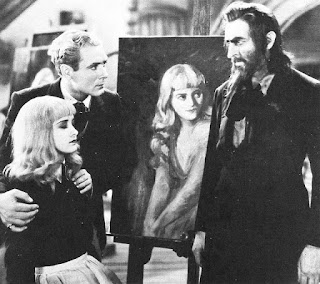 |
| Marian Marsh, Bramwell Fletcher, John Barrymore, Svengali |
MAD, BAD AND DANGEROUS TO KNOW.
In 1939, John Barrymore, one of the most accomplished actors of his time but by then bankrupt and ruined by booze, agreed to appear on stage in My Dear Children. The play was rubbish but, in a way, that was the idea. Barrymore could barely retain lines anyway, but he got by with ad-libbing and misbehaving, which was what audiences hoped to see. They were not disappointed. Biographer John Kobler wrote that “Together with clowning, mugging, grunts, snorts, rumbles, yawns, bleats, leers, smirks, ogles, roars, squirts, eye rolling, eyebrow-twitching, strutting, mincing, pouncing, staggering, hip-skipping and jumps, profanity, obscenity and general horseplay, Barrymore would turn a vapid farce into a freakish smash hit unique in theatre annals.”
 |
| Luis Alberni as the cocaine-crazed Bakieff, The Mad Genius |
My Dear Children paid off Barrymore’s debts. In 1942, when he died, aged sixty, his finances were sound but his reputation, like his body, was a ruin. Among the collateral damage of his demise were Svengali, The Mad Genius and Moby Dick. He had a financial interest in all three, and his heirs haggling over profits kept them out of circulation for years. Even today, The Mad Genius is less seen, probably because Luis Alberni’s ballet director is enthusiastically addicted to cocaine.
Anyone coming to the cinema and theatre for the first time today will be baffled by Barrymore’s reputation, since only a handful of films survive, most of them bad. In a couple, he’s admittedly inspired. As a manic Broadway producer inTwentieth Century, his flamboyance fits the character. And he’s touchingly vulnerable opposite Katharine Hepburn in A Bill of Divorcement. (They were due to appear together again in Break of Hearts, Barrymore as a Stokowski-like orchestral conductor, until he invited Hepburn to his dressing room, and greeted her reclining naked.)
John’s brother and sister Lionel and Ethel also went into movies but John had the greatest success, playing Don Juan, Jekyll and Hyde, François Villon, Arsène Lupin and Captain Ahab. When George Cukor filmed the Edna Ferber/George S. Kaufman parody of the Drew/Barrymore dynasty as The Royal Family of Broadway, Fredric March was a spirited John. Lamenting him having abandoned Broadway for Hollywood, the family matriarch, glimpsing an advertisement for his latest swashbuckler, laments “Oh dear. All Action. All Talking. All Terrible.”
 |
| "no right angles", Svengali |
Svengali and The Mad Genius juxtapose Barrymore’s melodramatic technique with the Germanic expressionist style of designer Anton Grot. There are no right angles in the Parisian garrets ofSvengali. Walls and even floors curve eccentrically or run together at awkward angles. Muslin ceilings appear solid but admit light from above, permitting cinematographer Barney McGill to avoid cliché low lighting. Particularly in The Mad Genius, Curtiz has the camera stand back and frames an entire room with an almost proscenium effect that gives the performers room to move. Barrymore even perches on the furniture, and a Montmartre club owner, sitting on top of a piano, walks across tables and chairs to reach the stage. Both Grot and McGill received Oscar nominations.
 |
| Luis Alberni (Bankieff), John Barrymore (Tsarakov) The Mad Genius |
In both films, Barrymore plays, in essence, the same character, even to a similar make-up and hair-do, though in The Mad Genius Svengali's jutting beard and greasy quiff modulate into something more barbered as the itinerant puppeteer Tsarakov becomes a ballet impresario. Inspired by Serge Diaghilev, his character is actually closer to Anton Walbrook’s Lermontov in The Red Shoes, not the only point of resemblance between the two films.
Archie Mayo plays Svengali for melodrama, particularly when Barrymore, eyes blanked with opaque contacts, sends his consciousness out over the crooked roofs of a Caligari-esque Paris to summon Trilby. There is nothing so Grand Guignol in The Mad Genius, unless it’s Luis Alberni’s towering shadow on the wall as he snorts his coke, and Tsarakov sadistically dropping decks of dope into a stove until the anguished director does his bidding. As a finale, Alberni runs amok on stage and despatches his torturer with a fire axe.
 |
| "automobile Hood ornaments" Donald Woods, Marian Marsh, The Mad Genius |
As in most Barrymore movies, other performers take a back seat. The doll-like Marian Marsh was a Barrymore favourite, hence her negligible presence in both films. Donald Woods, as the Nijinsky character in The Mad Genius, exhibits his customary collar-ad colourlessness, not helped by costumes that make the dancers resemble automobile hood ornaments. Among lesser appearances, the painters in Svengali for which Marsh poses include Philip Guston, who eeked out a living as a bit player before achieving fame. And Boris Karloff is barely recognisable as the peasant father who breaks up the puppet show in The Mad Genius looking for son Frankie Darro.
Twenty-five years later, Darro would find himself inhabiting the suit of Robby the Robot in Forbidden Planet. Who else but a two-metre tall man of steel could upstage Barrymore?
Click here to watch SVENGALI
Click here to watch THE MAD GENIUS
Click here to watch SVENGALI
Click here to watch THE MAD GENIUS
No comments:
Post a Comment
Note: only a member of this blog may post a comment.